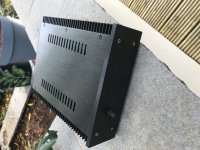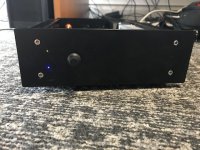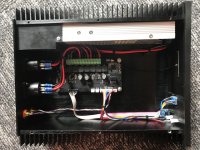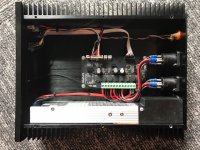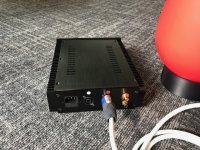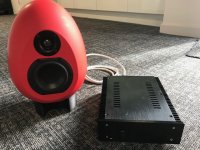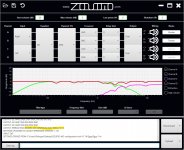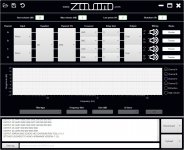The build...
Still not sure about the front panel yet. The Douk audio case came with a 8mm thick silver anodised ali one. I have 3D printed this one to test the layout.
As you can see I have remotely mounted the programming header so that it is accessible via the front panel. The LEDs have been recessed which makes them look a little more sleek in my mind. The PSU is a Mean Well UHP-200-24 dialed in at 26V which is pretty much its max and just under that of the chipamps. There is also a 3D printed finger guard around the incomming mains connections.
Now I just need to get to grips with the SW and tuning it all to run the eggs.
Still not sure about the front panel yet. The Douk audio case came with a 8mm thick silver anodised ali one. I have 3D printed this one to test the layout.
As you can see I have remotely mounted the programming header so that it is accessible via the front panel. The LEDs have been recessed which makes them look a little more sleek in my mind. The PSU is a Mean Well UHP-200-24 dialed in at 26V which is pretty much its max and just under that of the chipamps. There is also a 3D printed finger guard around the incomming mains connections.
Now I just need to get to grips with the SW and tuning it all to run the eggs.
Attachments
Dear Lutkeveld, I have been following this project with excitement for a looong time now. When I started speakerbuilding and especially portable projects many years ago, I remember reading your posts over and over again on every forum I found them. I have learned a lot following in you footsteps to say the least. Its so exciting to see this take form.
I have some questions regarding this board, haven't been find it, maybe you could help me:
1. Can I use different dsp setting for every channel? This 2.1 but mono thing got me confused. I need to use all channels, low+low+mid+tweeter. Will this configuration be possible?
2. I intend to use two amp boards and connect them via true wifi for a stereo system, and I started thinking, what is the delay time when using one board as slave? Will this make video watching on netflix impossible?
3. I've heard that bluetooth 5.0 will have a/v sync, is BT 5.0 on the list?
4. I'm a DJ when nobody watches, and intend to hook up my mixer via rca to the aux in on the plate amp ext kits. Will I loose bluetooth connection while hooking up to aux? How easy to switch between aux on each amp and BT true wireless stereo?
Thanks in advance!
I have some questions regarding this board, haven't been find it, maybe you could help me:
1. Can I use different dsp setting for every channel? This 2.1 but mono thing got me confused. I need to use all channels, low+low+mid+tweeter. Will this configuration be possible?
2. I intend to use two amp boards and connect them via true wifi for a stereo system, and I started thinking, what is the delay time when using one board as slave? Will this make video watching on netflix impossible?
3. I've heard that bluetooth 5.0 will have a/v sync, is BT 5.0 on the list?
4. I'm a DJ when nobody watches, and intend to hook up my mixer via rca to the aux in on the plate amp ext kits. Will I loose bluetooth connection while hooking up to aux? How easy to switch between aux on each amp and BT true wireless stereo?
Thanks in advance!
This amp looks really great! Just registered to the forum 😉
I want to use the amp to power my "Sonnenschein" speakers (Sonnenschein). There is one Fullrange Visaton BG20 per side. Should I bridge 2 channels for left an right? Or how would you operate the two loudspeakers?
Left: 1x BG20 (8 ohm)
Right: 1x BG20 (8 ohm)
I want to use the amp to power my "Sonnenschein" speakers (Sonnenschein). There is one Fullrange Visaton BG20 per side. Should I bridge 2 channels for left an right? Or how would you operate the two loudspeakers?
Left: 1x BG20 (8 ohm)
Right: 1x BG20 (8 ohm)
@oon Mono means the average of the sum ( (L+R)/2 ). So instead of left/right satellites its currently only possible to send them both mono.
@gary What do you mean with "only seems to display some of the filters"? The only things you can toggle are:
-EQ14 and EQ15, which are (de)activated by the EQ button.
-High vs low dynamic EQ
Other than that: all filters, EQ and XO, are always displayed.
The equalizer (EQ) are filters that are applied to all channels.
The crossover (XO) are filters that are applied to a single channel.
Nice build! Casing looks professional.
@REIER
Good to hear! To answer your questions:
1) Have a look at the configuration tool. You can see which channels pass through which filter blocks. You can apply filters to all channels (EQ) or set them per channel (crossover). Or a combination of both ofcourse 🙂
2) TWS stands for True Wireless Stereo, its handled via Bluetooth. I am not 100% sure about the latency. It supports APTX low latency, which has 34ms delay. But first of all, your source needs to support that, and second: I do not know if its active on a TWS connection. To avoid lip sync issues, its best to use a wired connection.
3) What is a/v sync? BT5.0 is on the list for future products. Im working on a board with TAS5805M amplifiers and BT5.0.
4) BT has priority. If the BT has no active stream or is disconnected, the AUX will be active.
@ill Thanks! How many channels do you need for that? This one already has 4 🙂
@livero If you only need two channels its indeed recommended to bridge the channels to make it a 2 channel amp. Much luck with your build!
@Pelanj Nice! Be sure to post some pictures of your project!
@gary What do you mean with "only seems to display some of the filters"? The only things you can toggle are:
-EQ14 and EQ15, which are (de)activated by the EQ button.
-High vs low dynamic EQ
Other than that: all filters, EQ and XO, are always displayed.
The equalizer (EQ) are filters that are applied to all channels.
The crossover (XO) are filters that are applied to a single channel.
Nice build! Casing looks professional.
@REIER
Good to hear! To answer your questions:
1) Have a look at the configuration tool. You can see which channels pass through which filter blocks. You can apply filters to all channels (EQ) or set them per channel (crossover). Or a combination of both ofcourse 🙂
2) TWS stands for True Wireless Stereo, its handled via Bluetooth. I am not 100% sure about the latency. It supports APTX low latency, which has 34ms delay. But first of all, your source needs to support that, and second: I do not know if its active on a TWS connection. To avoid lip sync issues, its best to use a wired connection.
3) What is a/v sync? BT5.0 is on the list for future products. Im working on a board with TAS5805M amplifiers and BT5.0.
4) BT has priority. If the BT has no active stream or is disconnected, the AUX will be active.
@ill Thanks! How many channels do you need for that? This one already has 4 🙂
@livero If you only need two channels its indeed recommended to bridge the channels to make it a 2 channel amp. Much luck with your build!
@Pelanj Nice! Be sure to post some pictures of your project!
So if I understand you correctly all 4 channels are (L+R/2) at the moment and it cannot be changed until the next revision?@oon Mono means the average of the sum ( (L+R)/2 ). So instead of left/right satellites its currently only possible to send them both mono.
@gary What do you mean with "only seems to display some of the filters"? The only things you can toggle are:
-EQ14 and EQ15, which are (de)activated by the EQ button.
-High vs low dynamic EQ
Other than that: all filters, EQ and XO, are always displayed.
The equalizer (EQ) are filters that are applied to all channels.
The crossover (XO) are filters that are applied to a single channel.
Nice build! Casing looks professional.
@REIER
Good to hear! To answer your questions:
1) Have a look at the configuration tool. You can see which channels pass through which filter blocks. You can apply filters to all channels (EQ) or set them per channel (crossover). Or a combination of both ofcourse 🙂
2) TWS stands for True Wireless Stereo, its handled via Bluetooth. I am not 100% sure about the latency. It supports APTX low latency, which has 34ms delay. But first of all, your source needs to support that, and second: I do not know if its active on a TWS connection. To avoid lip sync issues, its best to use a wired connection.
3) What is a/v sync? BT5.0 is on the list for future products. Im working on a board with TAS5805M amplifiers and BT5.0.
4) BT has priority. If the BT has no active stream or is disconnected, the AUX will be active.
@ill Thanks! How many channels do you need for that? This one already has 4 🙂
@livero If you only need two channels its indeed recommended to bridge the channels to make it a 2 channel amp. Much luck with your build!
@Pelanj Nice! Be sure to post some pictures of your project!
Okay, wait for the next one. My thoughts are you should let the user set and choose themselves whether it would be L,R or (L+R)/2 to get more flexibility.
I was thinking of using for experimental 2.1 and active 2 way set ups.
Hence this request. Some of us might want to use it as 4 way system.
Oon
@ill
Each filter is a biquad, which is 2nd order at (-12dB/octave). So for example, you have 5 crossovers, so you have a maximum steepness of 5*12dB=60db/oct
@oon
No you can also send just left or just right. But most people will choose mono for now.
Just download the tool, you will see the possibilities 🙂
Each filter is a biquad, which is 2nd order at (-12dB/octave). So for example, you have 5 crossovers, so you have a maximum steepness of 5*12dB=60db/oct
@oon
No you can also send just left or just right. But most people will choose mono for now.
Just download the tool, you will see the possibilities 🙂
Lutkeveld
Thanks. The case is nice and compact but still has plenty of space. I got it after I found the PSU would fit and that it matches the DAC case Douk Audio also sell into which I have built a PiCorePlayer. Not sure yet but there is enough space to integrate the two together in one case I guess with the Pi > I2C reclocker > Zoudio
Anyways back to the software. Some of it is definatley finding my way around it but at the same time there are also some funnies going on. My initial comments were based on my first play. However after restarting the program it started to behave.
Yesterday I completely lost the B trace and it only came back after a program restart. Also traces C/D showed as completly flat even though there were EQ setttings applied. I think it is the screen feedback and funnies that are confusing me at the moment.
The attached screen grab shows what I'm currently playing with together with a ZIPed .ini file.
I'm using V1.1.4 but in the log window it says V1.1.3?
@gary What do you mean with "only seems to display some of the filters"? The only things you can toggle are:
-EQ14 and EQ15, which are (de)activated by the EQ button.
-High vs low dynamic EQ
Other than that: all filters, EQ and XO, are always displayed.
The equalizer (EQ) are filters that are applied to all channels.
The crossover (XO) are filters that are applied to a single channel.
Nice build! Casing looks professional.
Thanks. The case is nice and compact but still has plenty of space. I got it after I found the PSU would fit and that it matches the DAC case Douk Audio also sell into which I have built a PiCorePlayer. Not sure yet but there is enough space to integrate the two together in one case I guess with the Pi > I2C reclocker > Zoudio
Anyways back to the software. Some of it is definatley finding my way around it but at the same time there are also some funnies going on. My initial comments were based on my first play. However after restarting the program it started to behave.
Yesterday I completely lost the B trace and it only came back after a program restart. Also traces C/D showed as completly flat even though there were EQ setttings applied. I think it is the screen feedback and funnies that are confusing me at the moment.
The attached screen grab shows what I'm currently playing with together with a ZIPed .ini file.
I'm using V1.1.4 but in the log window it says V1.1.3?
Attachments
The B trace is only not displayed when you select output AB as single. Otherwise it should always be active.
C and D seem to match your settings right?
Yes I did not update the internal version number by accident. V1.1.3 and V1.1.4 are different, but they report the same version number when uploading.
C and D seem to match your settings right?
Yes I did not update the internal version number by accident. V1.1.3 and V1.1.4 are different, but they report the same version number when uploading.
Your definition of 2.1 Mono confused me.@ill
Each filter is a biquad, which is 2nd order at (-12dB/octave). So for example, you have 5 crossovers, so you have a maximum steepness of 5*12dB=60db/oct
@oon
No you can also send just left or just right. But most people will choose mono for now.
Just download the tool, you will see the possibilities 🙂
So just wanted to confirm it can do this before buying.
1) L and R and (L+R)/2 for the sub.
2) L high pass, L low pass and the same for a right to form a bi amp stereo system.
Thanks.
Oon
Oon, sorry for my perhaps confusing previous reply. I'm running "L high pass, L low pass and the same for a right to form a bi amp stereo system". I guess that would be "2.2", vs "2.1". Unless the woof has dual VCs!...
Hi,
No problem, actually luketveld said the same, because 2 channel means stereo, 2.1 normally means stereo + subwoofer, since it only covers part of the frequency it considered (.1). So when the term 2.1 mono comes in, it becomes really confusing... I was thinking the satellites are mono...
Oon
No problem, actually luketveld said the same, because 2 channel means stereo, 2.1 normally means stereo + subwoofer, since it only covers part of the frequency it considered (.1). So when the term 2.1 mono comes in, it becomes really confusing... I was thinking the satellites are mono...
Oon
Actually the satellites are mono and that is what @luketveld is working on to make the satellites stereo in a 2.1 mode.
I wouldn’t mind hearing an update on how this is going.
I wouldn’t mind hearing an update on how this is going.
Oh oh... back to square one.
Luketveld, can you clarify this? Is it going to output stereo or mono for the satellites?
Oon
Luketveld, can you clarify this? Is it going to output stereo or mono for the satellites?
Oon
@oon
What you thought it was, is what is confirmed by synquasi, so no need to go back to square one 🙂
The sattelites can only be set to one thing right now (mono/left/right), individual control is being worked on. To keep the thread clean, for furter questions about the mono thing: please send a mail or DM
@gary
Mm okay, thanks for your feedback.
Did they dissappear after pressing upload?
What happens if you untick and then tick the box?
What you thought it was, is what is confirmed by synquasi, so no need to go back to square one 🙂
The sattelites can only be set to one thing right now (mono/left/right), individual control is being worked on. To keep the thread clean, for furter questions about the mono thing: please send a mail or DM
@gary
Mm okay, thanks for your feedback.
Did they dissappear after pressing upload?
What happens if you untick and then tick the box?
Its special that you don't seem to be able to define the channel situation in a clear and simple manner... how har can it be?
Does it do stereo or not? After all, this is the vendor section...
//
Does it do stereo or not? After all, this is the vendor section...
//
Last edited:
Yeah feedback it is as it’s not a show stopper but it did confuse me initially. When it has happened before it has just been with one or two traces. Unticking them and ticking them again does not reset it but restarting the program does. Have not identified what triggers it though
- Home
- Vendor's Bazaar
- ZOUDIO AIO4CH: 4-channel amplifier with DSP and Bluetooth
